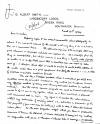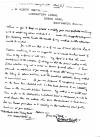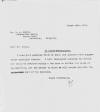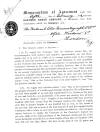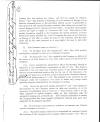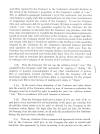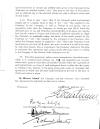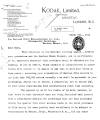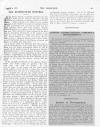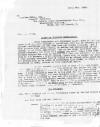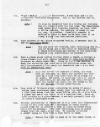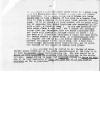KINEMACOLOR Miscellanea
Beginnings of Kinemacolor
G Albert Smith wrote to Charles Urban proposing that they work together on March 21st 1904;
This is what he said:
Letter from G Albert Smith F.R.A.S, Laboratory Lodge, Green Road, Southwick,Brighton.
March 21st 1904
Dear Mr Urban,
Referring again to our recent conversation about photography in colours, I am now quite assured of the results, & the only thing to do is to produce them on a commercial basis. The apparatus requires to be so simple that any good showman or Bioscope exhibitor can exploit it. As a scientific fact the thing is accomplished, but whilst science is one thing a healthy sale of goods is another & it is the latter point that as a practical man we want to take care of. I therefore think that it would be unwise to invite public attention to the matter until there is a good commitment to supply the demand – i.e. a stock of pictures & suitable machines for sale.
The old Lee & Turner patent, which I understand you still own doubtless covers the principle involved in my method (as I suppose it covers any effective method of taking and showing animated pictures in natural colours). But the actual camera, projector, etc used in Turners experiments would be of no use in my system, which, as I have mentioned, is planned without any dislocation of existing plant, i.e. exhibitors in possession of the best projectors (your new ones for instance) will be able to show the natural colour films. As the new projection outfit which you have in preparation promises to become the standard, it seems desirable to carry out my methods in conjunction with yours, & therefore I should like to arrange a co-operative scheme – you to keep me posted & supply your new perfected machinery & I to adapt my colour methods to it. Under this suggested arrangement your company would handle the results of my methods, & the advantage would be mutual.
You will see that it is of no use to send the old Lee & Turner machinery to me as suggested as it would be a sheer waste of time to try & force it into use. My object is to link the new development to the situation of today, so that the present method & the future addition may act & react in favour of each other. I have planned, as explained to you recently to devote the coning summer to the taking of colour pictures, & to the practical application of my method to commercial use. If you are prepared to co-operate somewhat on the lines here sketched out, I shall look forward to an interesting boom in animated picture business. My method is on quite new lines as far as the photographic & pictorial part is concerned, & will be much cheaper than old methods when once the equipment is laid down. Let me know your ideas as to assisting in the mechanical part of the business at your earliest –,
believe me
Yours very truly
G Albert Smith
To the Charles Urban Trading Co Ltd
48 Rupert Street, W
This is Charles Urban's reply dated 24th march 1904
This is the contract signed with the Eastman Kodak Co. dated February 5th 1912 and a letter from Kodak Ltd dated March 6th 1912 regarding the purchase of film stock.
It is interesting that the film is described as approximately 1 3/8" in width in 1a and approximately 35mm or 1 1/38" in 1b for unperforated film.
Article from 'The Bioscope' dated March 4 1909
Because panchromatic film (sensitive to all colour light) was not available at the time, the current negative which was orthochromatic (sensitive to blue and green light only) had to be treated to make it sensitive to red light. Correspondence indicates that they were having trouble in the US sensitizing the film. This is a letter written by G Albert Smith to Charles Urban explaining how to sensitize film. The letter is dated April 9th 1913.
This is what the letter says:
April 9th. 1913.
To
Charles Urban, Esq.,
Managing Director,
The Natural Color Kinematograph Co., Ltd.,
Kinemacolor Building,
80-82, Wardour Street, W.
Dear Mr. Urban
Notes on Improved Sensitizing
After exhaustive and pro1onged experiments it has been found that superior results in sensitized film can be secured; & the altered conditions are set down here for future guidance. But I must promise that every detail, no matter how unimportant it may appear, is of vital importance. One or two steps indicated may appear pedantic, but there is a reason for every step, & the best uniform results can only be secured by faithful attention to ever step of the process — which process, after all., is simplicity itself I have already recorded: (see my letter to Mr Hickey dated March 26/: the precautions to be taken in purchasing film stock, so there is no necessity to dwell further on this important point.
In the present process use is made of the dye called Pinacyanol a dye which sensitizes strongly for yellow and red, but has peculiarities rendering it very tricky for commercial use. I have frequently used it in the past preparation of film with my own hands, and but have hitherto hesitated to recommend its use by less experienced or less watchful workers in a commercial way, because of the unexpected results occasionally cropping up in its behaviour which might lead to a great waste & disappointment. But I am now content that if every step of the process here described is faithfully followed there is no risk of disaster.
The Process
1st. Weigh exactly .06 gramme Pinacyanol (made by Meister Lucius & Brunig)
Put this into 220 cc. Alcohol
Note: The dye will not all dissolve immediately. My own practice is to put the alcohol into a glass stoppered bottle and the dye – shake it up a little & use it next day. It keeps perfectly, & by having several hours to dissolve certainty in this respect is secured. When we are busy I have several bottles of dye dissolved & waiting for use.
2nd. Weigh exactly .45 gramme Pinachrome, & add this dye to the previously dissolved Pinacyanol. Add to the mixture 100 cc. Alcohol.
Note : It will be observed that the bottle now contains 320 cc. Alcohol with the two dyes. The Pinachrome last added wi11 dissolve readily, so that, with a little shaking, the mixture is ready to use in, say, l0.minutes. Carefully examine it against a light to make quite sure that it is clear & freer from undissolved particles.
3rd. Take another 14 oz. glass stoppered bottle, & measure into it 320 cc .distilled water.
Note : You now have two bottles, each containing 320 cc., one of mixed dye the other of distilled: water & these two bottles are handed to the dark—room foreman with instructions as follows: —
4th. Take a clean glass bottle holding about a quart, & through a glass funnel pour, into it the contents of both your bott1es prepared as above described. Shake up for a few minutes, & when the alcoholic dye solution & the distilled water are well incorporated it is ready for immediate use — & in fact must be immediately used.
Note : From the moment the mixture is made, the work must go straight on. Until the mixture has been used up & done with there must be no going out to lunch. If lunch, or anything else, is likely to interfere, do not mix the two small bottles into the larger one until you are ready to see the job through without interruption.
5th. Your sink of filtered water containing 56 pints (7 gals.) having been previously made ready, pour the mixture of dyes & distilled water from the large bottle into it, & stir with a glass rod until the whole is of a uniform tint. Bale up some samples in a glass beaker, & satisfy yourself that all is clear & uniformly mixed.
6th. Proceed immediately to sensitize in this bath (the temperature should be not less than 64°) according to usual custom — namely soak for 11 minutes & wash in clean filtered water baths for 10 minutes. Give each succeeding film 1/2 minute longer than the last, as of old. We usually sensitize 8 —200 ft rolls in this & then throw it away.
Note : Unless the bath is made up by the exact steps, & in the exact quantities given above there is a great risk that the Pinacyanol will "flock" — i.e. will not remain in solution. It is wise, while the 6 frames are being sensitized to take a sample of the bath in a beaker from time to time & examine it in a good light outside the dark room. If it Is clear& of good colour, all is going well, but if numerous’ tiny black particles are suspended in it call a halt, & throw 4.t away! In our own practice the bath keeps clean & acts well, but I cannot too strongly insist that any departure from the exact procedure here set forth will result in failure sooner or later — i.e., the bath will "flock" as described & spoil the film stock. The German makers or these dyes, in correspondence, with me, suggest the use of glacial acetic acid & ammonia to prevent ‘flocking’ in the water bath, but I find that these things introduce other difficulties, all of which are avoided by the method or mixing here given.
I have already (see my letter to Mr. Hickey of March18/13) drawn attention to the extra sensitiveness of the film if it is very thoroughly dried before packing up. The aim should be to expel as much moisture as is possible from the gelatine in the drying process. Rapid drying is good, but thorough drying is twice as good and it is very desirable to keep the film dry up. to the time of exposure as far as possible.
